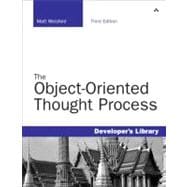
Note: Supplemental materials are not guaranteed with Rental or Used book purchases.
Purchase Benefits
What is included with this book?
Matt Weisfeld is an associate professor in business & technology at Cuyahoga Community College (Tri-C) in Cleveland, Ohio.A member of the information technology faculty, he focuses on programming, web development, and entrepreneurship. Prior to joining Tri-C,Weisfeld spent 20 years in the information technology industry gaining experience in software development, project management, small business management, corporate training, and part-time teaching. He holds an MS in computer science and an MBA in project management. Besides the first two editions of The Object-Oriented Thought Process, he has published two other computer books and articles in magazines and journals such as developer.com, Dr. Dobb’s Journal, The C/C++ Users Journal, Software Development Magazine, Java Report, and the international journal Project Management.
| Introduction | p. 1 |
| Introduction to Object-Oriented Concepts | p. 5 |
| How to Think in Terms of Objects | p. 37 |
| Advanced Object-Oriented Concepts | p. 53 |
| The Anatomy of a Class | p. 75 |
| Class Design Guidelines | p. 87 |
| Designing with Objects | p. 103 |
| Mastering Inheritance and Composition | p. 129 |
| Frameworks and Reuse: Designing with Interfaces and Abstract Classes | p. 151 |
| Building Objects | p. 179 |
| Creating Object Models with UML | p. 193 |
| Objects and Portable Data: XML | p. 207 |
| Persistent Objects: Serialization and Relational Databases | p. 225 |
| Objects and the Internet | p. 247 |
| Objects and Client/Server Applications | p. 271 |
| Design Patterns | p. 287 |
| Index | p. 309 |
| Table of Contents provided by Blackwell. All Rights Reserved. |
The New copy of this book will include any supplemental materials advertised. Please check the title of the book to determine if it should include any access cards, study guides, lab manuals, CDs, etc.
The Used, Rental and eBook copies of this book are not guaranteed to include any supplemental materials. Typically, only the book itself is included. This is true even if the title states it includes any access cards, study guides, lab manuals, CDs, etc.